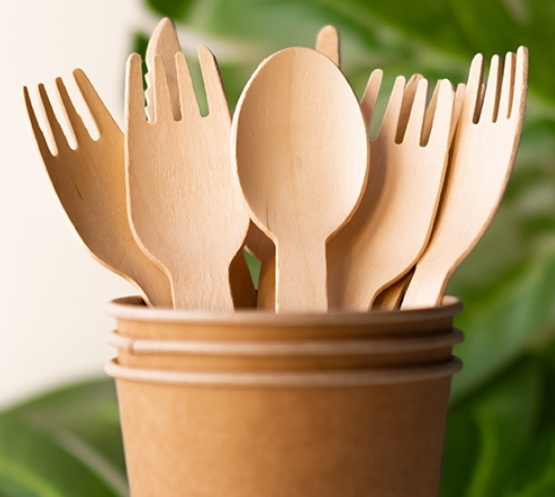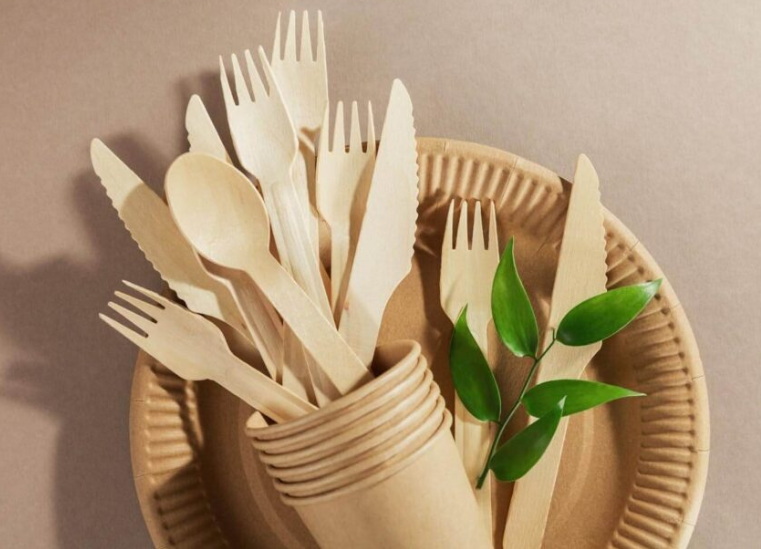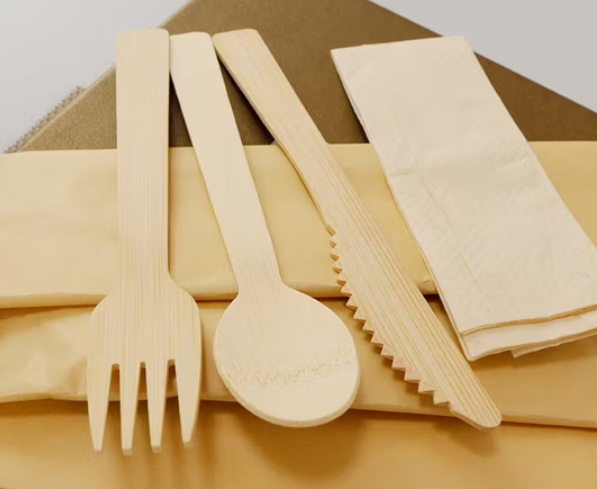
Content Menu
● Introduction to Disposable Cutlery Sets
>> Traditional Plastic Cutlery
● Sustainable Alternatives
>> Wooden Cutlery
>> Bamboo Cutlery
>> Bioplastics (CPLA)
>> Plant Fibre Cutlery
>> Sugarcane Bagasse Cutlery
>> Paper Cutlery
>> Edible Cutlery
● Comparison of Materials
● Choosing the Right Disposable Cutlery Set
>> For Events and Catering
>> For Everyday Use
● Environmental Impact
● Market Trends and Innovations
● Future Outlook
● Conclusion
● FAQs
>> 1. What is the most eco-friendly disposable cutlery material?
>> 2. How long does it take for wooden cutlery to decompose?
>> 3. Can plastic cutlery be reused?
>> 4. What are the benefits of using bamboo cutlery?
>> 5. How does plant fibre cutlery contribute to sustainability?
● Citations:
The demand for disposable cutlery sets has been on the rise due to their convenience and widespread use in various settings, such as outdoor events, takeout services, and catering. However, with growing environmental concerns, the choice of material for these sets has become increasingly important. In this article, we will explore the best materials for disposable cutlery sets, focusing on their sustainability, durability, and aesthetic appeal.

Introduction to Disposable Cutlery Sets
Disposable cutlery sets are designed to provide a convenient and hygienic way to enjoy meals without the need for washing and reusing utensils. They are commonly used in food service industries, including restaurants, food trucks, and event catering. The materials used for these sets vary widely, ranging from traditional plastics to more sustainable options like wood, bamboo, and bioplastics.
Traditional Plastic Cutlery
Traditional plastic cutlery is made from materials such as polypropylene and polystyrene. These plastics are inexpensive and widely available but have significant environmental drawbacks. They are non-biodegradable, contributing to long-term waste and pollution issues.
Sustainable Alternatives
Wooden Cutlery
Wooden cutlery is made from renewable resources like birch and bamboo. It is biodegradable and compostable, offering a natural aesthetic that is popular for eco-conscious events. Wooden cutlery is durable and can withstand various temperatures, making it suitable for both hot and cold foods.
Bamboo Cutlery
Bamboo is a rapidly renewable resource, making it an excellent choice for sustainable cutlery. Bamboo utensils are durable, lightweight, and compostable, with a fast decomposition rate. They are also resistant to high temperatures, making them suitable for microwave use.
Bioplastics (CPLA)
Bioplastics, such as crystallized polylactic acid (CPLA), are made from plant-based materials like corn starch. They are compostable and offer a more environmentally friendly alternative to traditional plastics. Bioplastics are heat-resistant and can be used for both hot and cold foods.
Plant Fibre Cutlery
Plant fibre cutlery is made from agricultural by-products such as corn starch and sugarcane. It is compostable and decomposes quickly, reducing waste and pollution. This material is also renewable and sustainable, as it utilizes waste products that would otherwise be discarded.
Sugarcane Bagasse Cutlery
Sugarcane bagasse cutlery is made from the fibrous residue left behind after sugarcane juice extraction. These utensils are biodegradable and compostable, offering a viable alternative to traditional plastic and paper-based disposable cutlery. They are heat-resistant and microwave-safe, making them suitable for various culinary applications.
Paper Cutlery
Paper cutlery is a cost-effective and biodegradable option. It is lightweight and decomposes rapidly, making it suitable for large-scale use. However, it may not be as durable as other materials and can become soggy when exposed to moisture.
Edible Cutlery
Edible cutlery is an innovative approach to reducing waste by turning your utensils into part of the meal itself. Made from ingredients like flour, rapeseed oil, salt, and natural flavors, these utensils possess the taste and texture akin to crackers. This option not only reduces waste but also offers a unique dining experience.

Comparison of Materials
| Material | Key Benefits | Drawbacks | Decomposition Time |
| Wooden | Durable, Compostable | Splinters, Longer Decomposition | 6-12 months |
| Bamboo | Fast-growing, Stylish | Sensitive to High Temperatures | 4-6 weeks |
| CPLA | Compostable, Heat-resistant | Rigid, Breaks Under Pressure | 60-180 days |
| Plant Fibre | Fast Composting, Renewable | Limited Availability, Not Durable | 60 days |
| Sugarcane Bagasse | Heat-resistant, Microwave-safe | Limited Availability | 60 days |
| Paper | Cost-effective, Rapid Decomposition | Limited Durability | 2-6 weeks |
| Edible | Reduces Waste, Unique Experience | Limited Availability, Expensive | N/A |
Choosing the Right Disposable Cutlery Set
When selecting a disposable cutlery set, consider factors such as intended use, environmental impact, and budget. For events requiring a touch of elegance, luxury plastic or biodegradable options might be suitable. For eco-conscious businesses, wooden or bamboo cutlery sets are ideal.
For Events and Catering
- Luxury Plastic Cutlery: Offers a high-end feel without the environmental drawbacks of traditional plastics.
- Biodegradable Cutlery: Suitable for eco-friendly events, reducing waste and pollution.
For Everyday Use
- Wooden or Bamboo Cutlery: Provides a sustainable and durable option for daily use.
Environmental Impact
The environmental impact of disposable cutlery is significant, with traditional plastics contributing to pollution and waste. Switching to biodegradable materials can reduce plastic waste by up to 30% in urban areas. The production process for sustainable cutlery often involves less energy and emits fewer greenhouse gases than traditional plastic manufacturing.
Market Trends and Innovations
The disposable cutlery market is witnessing significant innovations, with companies actively exploring new materials that offer a balance between durability and biodegradability. The development of plant-based polymers, bamboo blends, and edible cutlery are key trends shaping the future of disposable utensils. Major players in the market are investing in sustainable products and expanding manufacturing capabilities to meet the growing demand for eco-friendly options.
For instance, companies like EcoWareTech are leading the charge in sustainability by providing high-quality, eco-friendly cutlery made from renewable materials like bamboo and wood. Similarly, innovations such as sugarcane bagasse cutlery and edible cutlery are gaining traction due to their environmental benefits and unique dining experiences.
Future Outlook
The disposable cutlery market is expected to continue growing as consumer demand for convenient and eco-friendly products increases. With a forecasted market size of USD 14.87 billion by 2030, businesses have a unique opportunity to capitalize on the shift toward sustainability by adopting innovative materials and processes.
As consumers become more environmentally conscious, the demand for eco-friendly disposable cutlery is expected to rise. Companies that invest in sustainable materials and technologies will not only reduce their environmental footprint but also gain a competitive edge in the market.
Conclusion
Disposable cutlery sets are an essential component of modern food service, but their environmental impact cannot be ignored. By choosing sustainable materials like wood, bamboo, and bioplastics, businesses can reduce their ecological footprint while maintaining convenience and functionality. As consumers become more environmentally conscious, the demand for eco-friendly disposable cutlery is expected to grow.

FAQs
1. What is the most eco-friendly disposable cutlery material?
- The most eco-friendly disposable cutlery materials are wooden, bamboo, and bioplastics like CPLA. These materials are biodegradable and compostable, reducing environmental waste.
2. How long does it take for wooden cutlery to decompose?
- Wooden cutlery typically decomposes within 6 to 12 months in a composting environment.
3. Can plastic cutlery be reused?
- While plastic cutlery can be reused, it is not recommended due to hygiene concerns. Reusing plastic utensils can lead to bacterial growth and contamination.
4. What are the benefits of using bamboo cutlery?
- Bamboo cutlery is durable, lightweight, and compostable. It is made from a rapidly renewable resource and offers a stylish alternative to traditional plastics.
5. How does plant fibre cutlery contribute to sustainability?
- Plant fibre cutlery is made from agricultural by-products, reducing waste and pollution. It decomposes quickly, making it a low-carbon solution for disposable cutlery needs.
Citations:
[1] https://ecowaretech.com/2025-2030-global-disposable-cutlery-market-report/
[2] https://www.quitplastic.in/post/sustainable-innovations-sugarcane-bagasse-cutlery-more-than-just-a-spoon-and-fork
[3] https://www.researchandmarkets.com/reports/5820153/disposable-cutlery-market-report
[4] https://www.cleanthesky.com/innovation/koovee
[5] https://yashtech.biz/the-new-era-of-eco-friendly-cutlery/
[6] https://www.greenpower.org.hk/eng-all-about-greens/calling-for-comprehensive-regulation-of-disposable-plastic-tableware
[7] https://www.globenewswire.com/news-release/2025/02/10/3023429/0/en/Global-Disposable-Cutlery-Market-Projected-to-Reach-USD-2-486-3-Million-by-2035-Driven-by-Rising-Demand-for-Convenience-in-Foodservice-and-Hospitality-Sectors-FMI.html
[8] https://jollychef.com/blogs/news/the-future-of-disposable-tableware-sustainability-innovation-design-trends-for-2025
[9] https://www.epd.gov.hk/epd/sites/default/files/epd/english/environmentinhk/waste/pub_consult/files/tableware-con-doc-en.pdf
[10] https://www.futuremarketinsights.com/reports/disposable-cutlery-market
[11] https://app.co.id/-/foopak-and-ecotensil-team-up-to-offer-an-alternative-to-single-use-plastic-cutlery-that-has-much-better-taste-appeal-than-wood-utensils%C2%A0
[12] https://www.info.gov.hk/gia/general/202310/18/P2023101800622.htm
[13] https://blog.tbrc.info/2025/03/disposable-cutlery-market-2/
[14] https://supplycaddy.com/what-are-the-innovations-in-biodegradable-disposable-cutlery-materials-from-fork-to-future/
[15] https://genaq.com/impact-plastic-cutlery/
[16] https://markwideresearch.com/asia-pacific-disposable-cutlery-market/
[17] https://www.biopak.com/au/cutlery-straws

















